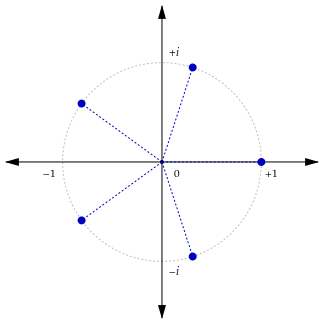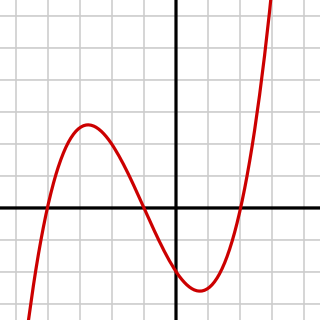
An algebraic number is a number that is a root of a non-zero polynomial in one variable with integer coefficients. For example, the golden ratio, , is an algebraic number, because it is a root of the polynomial x2 - x - 1. That is, it is a value for x for which the polynomial evaluates to zero. As another example, the complex number is algebraic because it is a root of x4 + 4.

In geometry and algebra, a real number is constructible if and only if, given a line segment of unit length, a line segment of length can be constructed with compass and straightedge in a finite number of steps. Equivalently, is constructible if and only if there is a closed-form expression for using only integers and the operations for addition, subtraction, multiplication, division, and square roots.
In mathematics, particularly in algebra, a field extension is a pair of fields such that the operations of E are those of F restricted to E. In this case, F is an extension field of E and E is a subfield of F. For example, under the usual notions of addition and multiplication, the complex numbers are an extension field of the real numbers; the real numbers are a subfield of the complex numbers.
In mathematics, the discriminant of a polynomial is a quantity that depends on the coefficients and determines various properties of the roots. It is generally defined as a polynomial function of the coefficients of the original polynomial. The discriminant is widely used in polynomial factoring, number theory, and algebraic geometry. It is often denoted by the symbol .

In mathematics, Galois theory, originally introduced by Évariste Galois, provides a connection between field theory and group theory. This connection, the fundamental theorem of Galois theory, allows reducing certain problems in field theory to group theory, which makes them simpler and easier to understand.
In algebraic number theory, an algebraic integer is a complex number which is integral over the integers. That is, an algebraic integer is a complex root of some monic polynomial whose coefficients are integers. The set of all algebraic integers is closed under addition, subtraction and multiplication and therefore is a commutative subring of the complex numbers.

In mathematics, a root of unity, occasionally called a de Moivre number, is any complex number that yields 1 when raised to some positive integer power n. Roots of unity are used in many branches of mathematics, and are especially important in number theory, the theory of group characters, and the discrete Fourier transform.

In algebra, a cubic equation in one variable is an equation of the form
In mathematics, an irreducible polynomial is, roughly speaking, a polynomial that cannot be factored into the product of two non-constant polynomials. The property of irreducibility depends on the nature of the coefficients that are accepted for the possible factors, that is, the field or ring to which the coefficients of the polynomial and its possible factors are supposed to belong. For example, the polynomial x2 − 2 is a polynomial with integer coefficients, but, as every integer is also a real number, it is also a polynomial with real coefficients. It is irreducible if it is considered as a polynomial with integer coefficients, but it factors as if it is considered as a polynomial with real coefficients. One says that the polynomial x2 − 2 is irreducible over the integers but not over the reals.
Field theory is the branch of mathematics in which fields are studied. This is a glossary of some terms of the subject.
In mathematics, an algebraic equation or polynomial equation is an equation of the form
In mathematics, Dirichlet's unit theorem is a basic result in algebraic number theory due to Peter Gustav Lejeune Dirichlet. It determines the rank of the group of units in the ring OK of algebraic integers of a number field K. The regulator is a positive real number that determines how "dense" the units are.

In mathematics, the ring of integers of an algebraic number field is the ring of all algebraic integers contained in . An algebraic integer is a root of a monic polynomial with integer coefficients: . This ring is often denoted by or . Since any integer belongs to and is an integral element of , the ring is always a subring of .

In mathematics, a square is the result of multiplying a number by itself. The verb "to square" is used to denote this operation. Squaring is the same as raising to the power 2, and is denoted by a superscript 2; for instance, the square of 3 may be written as 32, which is the number 9. In some cases when superscripts are not available, as for instance in programming languages or plain text files, the notations x^2 or x**2 may be used in place of x2.
Kronecker's Jugendtraum or Hilbert's twelfth problem, of the 23 mathematical Hilbert problems, is the extension of the Kronecker–Weber theorem on abelian extensions of the rational numbers, to any base number field. That is, it asks for analogues of the roots of unity, as complex numbers that are particular values of the exponential function; the requirement is that such numbers should generate a whole family of further number fields that are analogues of the cyclotomic fields and their subfields.
In mathematics, a polynomial transformation consists of computing the polynomial whose roots are a given function of the roots of a polynomial. Polynomial transformations such as Tschirnhaus transformations are often used to simplify the solution of algebraic equations.
In mathematics, a CM-field is a particular type of number field, so named for a close connection to the theory of complex multiplication. Another name used is J-field.
In algebra, casus irreducibilis is one of the cases that may arise in solving polynomials of degree 3 or higher with integer coefficients algebraically, i.e., by obtaining roots that are expressed with radicals. It shows that many algebraic numbers are real-valued but cannot be expressed in radicals without introducing complex numbers. The most notable occurrence of casus irreducibilis is in the case of cubic polynomials that have three real roots, which was proven by Pierre Wantzel in 1843. One can see whether a given cubic polynomial is in so-called casus irreducibilis by looking at the discriminant, via Cardano's formula.
In mathematics, specifically the area of algebraic number theory, a cubic field is an algebraic number field of degree three.

In mathematics, an algebraic number field is an extension field of the field of rational numbers such that the field extension has finite degree . Thus is a field that contains and has finite dimension when considered as a vector space over .
![The number field Q([?]2) sits inside R, and the two embeddings of the field into C send every element in the field to another element of R, hence the field is totally real. TotallyReal.svg](http://upload.wikimedia.org/wikipedia/commons/thumb/0/06/TotallyReal.svg/338px-TotallyReal.svg.png)






